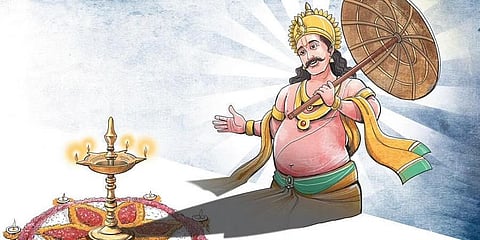

The marketing hype of Onam starts almost a month before the festival and lingers for another month when the fervour settles in. The coming of the great festival of abundance where people eat and drink adorned in new clothes to show their happiness to the mythical king who visits his country. Expelled by the gods from god’s own country, this defeated king who abdicated the throne and chose to retreat to the nether world returns. It is believed that he travels around the region, wishing his people a better new year. The Malayalis around the world and the consumer market of the state eagerly wait for the Onam festival days. Hefty rebates and sales are initiated on food, clothes and jewellery, with electronic media announcing them in full pitch and full-page advertisements overflowing out of newspapers and magazines. Interestingly in these advertisements, the supermodels and film stars will be replaced by an average potbellied man with a big moustache and a crown, holding a palm leaf umbrella—the expelled king of Kerala, Mahabali.
Almost a month after Onam’s euphoria got over in the media, I got a chance to travel to Badami, the ancient capital of the Western Chalukyas. This ancient capital, dotted with magnificent temples, has sculptures considered one of the earliest in Deccan and South India. According to the inscription on a pillar in Badami cave number 3, dated 578 CE, there is a magnificent image of Trivikrama, the 5th avatara of Lord Vishnu. The Trivikrama image of Vishnu carved on the right corner of the Veranda of Cave 3 extends his leg out into space, almost breaking the pictorial surface into the infinity of the sky. Underneath the all-expanding figure of Trivikrama is an image of King Bali offering the dana to the slightly mutilated Vamana figure. As a Keralite, I was thrilled to see the myth of Onam as visualised and masterly carved by the Chalukyan craftsmen with a handsome image of king Mahabali.
The myth of Trivikrama/Vamana, narrates the story of Lord Vishnu in the guise of a dwarf brahmin boy who tricks the mighty Asura king Bali into surrendering his vast empire encompassing the three worlds. Vamana, the young boy, asks for three steps of land, and Bali grants it, but Vamana reveals his massive form, covers the whole universe in two steps, and demands space for the third step. Realising that he has been duped by the gods for his arrogance of power, Bali offers his head to place Lord Vishnu’s divine step. Vishnu pushes Bali to patala and brings back the glory to the gods. It may be noted here that this is one of the few myths associated with Vishnu, which finds mention in the Vedas, sans the reference to Mahabali. Kerala’s version does not mention Trivikrama but adds that Vishnu permitted Mahabali to come back and visit his subjects once a year, celebrated as Onam.
Interestingly, though Onam is considered the dominant festival of Kerala and the Mahabali myth is the most popular, there is hardly any image of the Mahabali myth available in Kerala, either painted or sculpted. The image of Trivikrama is non-existent in Kerala temples, even where the temple structure is dedicated to Vamana or Trivikrama. On the other hand, you get ample images of Trivikrama in North, East and Western India, where no festivals commemorate the myth.
Almost all temples dedicated to Vishnu will have Trivikrama’s image in these regions. One of the oldest temples of India, datable to the 3rd century BCE, was dedicated to Trivikrama. Most of these images will have the image of Vamana and Bali beneath the figure Trivikrama. Whenever I see these images, I remain confused as the handsome Bali was not the icon of Bali I was familiar with.
The recurring images of Bali publicised in Kerala during the Onam festival through the media as advertisements were not of a handsome and well-built man but of a potbellied disproportionate middle-aged man with a rather dominant moustache almost covering his face. Even the village Onam celebration organising committees will look for a slightly grotesque potbellied man to lead the Onam processions as Maveli or Mahabali. Less potbellied Mahabalis will smile at you somewhat apologetically. It is still a mystery where the popular imagination of this image of Bali or Mahabali was created. Looking for images of Bali in Indian painting, I found the Vamana getting older, as in Pahari miniatures. I also saw the handsome and well-built golden armoured Bali kneeling in front of young Vamana in one of the Ravi Varma oleographs. But never found the Mahabali looking like a Gana jumped out of a Tamil Gopuram.
In childhood, apart from granny stories, our main source of myths was Amar Chitra Katha and Ambili Ammavan magazine [the Malayalam version of Chandamama], where the typology of mythological characters was predetermined. In that “pop-fiction”, the Asuras will have a big moustache and potbelly like the Nayaka period portraits and the Devas will have sharp and chiselled features like the David sculptures of the Italian Renaissance. Mahabali may be a hero to Keralites, but he remains an Asura king nevertheless. Thus, the “pop-fiction” Mahabali.
DR JAYARAM PODUVAL
Department of Art History& Aesthetics
The Maharaja Sayajirao University of Baroda
jpoduval@gmail.com